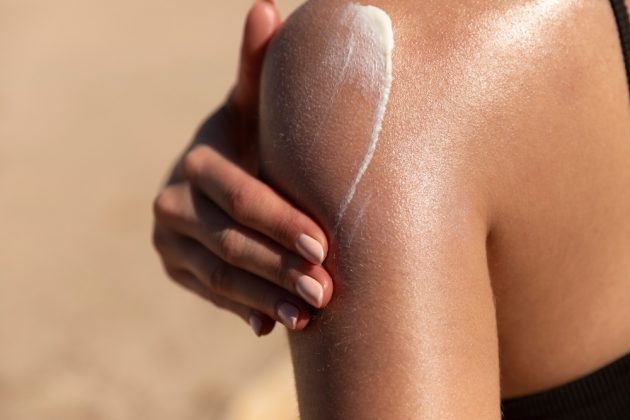Are you excited about the coming summer? Well, who doesn’t? Everyone loves the gorgeous white sand beaches, magnificent coral reefs, and refreshing sea breeze. That’s why summertime is always viewed as an escape from busy city life and a great time to consider crafting a new skincare routine.
As you know, summer is notorious for having longer daylight hours, high heat index, and humid weather. Unfortunately, these conditions aren’t good for your skin, as they increase the risk of developing acne and other skin issues.
Creating a summertime skincare routine may help prevent breakouts and other skin problems, such as irritations, inflammations, melasma, sunburns, and the like. This can be done with the help of various skincare products, such as sunblock, cleansers, and moisturizers.

With a powerful skincare routine, your skin can stay glowing and clear no matter how high the temperature is. In this post, you’ll learn the step-by-step skincare routine that can help you survive the summer without suffering from any skin condition. Keep on reading to find out more.
Should You Consider Tanning As A Part Of Your Skincare Routine
Since summer is coming, many people are wondering if tanning is worth being a part of their skincare routine. Does it help prevent acne?
Tanning can be used to treat vitamin D deficiency, an essential nutrient for stronger bones, joints, and muscles. When it comes to skincare, tanning may help reduce sebum production, lowering the risk of developing acne breakouts.
Although tanning may help treat acne problems, it comes with a lot of health risks. These include damaged skin cells, aging, and risk of skin cancers (e.g., malignant, basal cell, or squamous carcinoma). That said, it’d be best to leave tanning out of your skincare routine for your health.
To learn more about the connection between tanning and acne, you may check out this fantastic read or other similar resources.
What Should You Include In Your Summertime Skincare Routine
Here’s a step-by-step summertime skincare routine that can help protect your skin from all the risks of the summer season:
- Step 1: Cleanser
A cleanser is essential to any skincare routine, whether summer or not. It helps get rid of all the accumulated dirt, sebum, and grime that may cause skin problems, particularly the face and body acne.
When you buy a cleanser, look for one with active ingredients yet gentle on the skin. Two of the most popular active ingredients are benzoyl peroxide and salicylic acid, which can help reduce acne inflammation and prevent breakouts.
- Step 2: Exfoliator
An exfoliator is a cleanser-like skincare product that removes emerging dead skin cells on the surface of your skin. If left ignored, these dead cells can clog your pores and cause acne, particularly whiteheads.
Yet you shouldn’t exfoliate every single day. Why? Because it can remove the natural oils that protect and maintain your skin. Most dermatologists agree to exfoliate your skin twice or thrice weekly (in a not consecutive way).
- Step 3: Toner
Use a toner after cleansing your face. This will help remove the excess chemicals from the cleanser and refresh your skin without removing its natural hydration. Also, this will prepare your skin for moisturizers and other skin treatments.
When you buy a toner, look for one without alcohol and other harmful chemicals, such as parabens, phthalates, sulfates, and so on. In fact, alcohol can cause excessive dryness, promoting sebum production and resulting in more breakouts, irritation, and infections.
- Step 4: Serum And Moisturizer
Serums are often applied before moisturizers. These products contain high concentrations of active ingredients that address a particular skin problem. For example, a serum may contain high levels of hyaluronic acid, which helps treat excessive skin dryness by keeping the skin moist.
Other active ingredients that can be found in many serums include:
- Collagen for skin tightening;
- Vitamin C for skin brightening and spot correction;
- Retinol for anti-aging;
- Glycerin for skin hydration;
- Glycolic acid for skin exfoliation and cell turnover; and others.
Moisturizers are often applied next to serums. The main purpose of these products is to keep your skin hydrated and prevent dryness throughout the day without clogging your pores. Plus, they contain a small amount of active ingredients that potentially address specific skin concerns.
- Step 5: Sunscreens
Sunscreens are one of the essential components of a skincare routine, especially during summertime when the sun is high. These products help protect your skin from harmful ultraviolet rays (UV) that promote aging and cause other skin conditions (e.g., cancers and melasma).
When you buy sunscreen, look for a high sun protection factor (SPF), between SPF30 and SPF50, for optimum protection against UV rays.
Final Words
Summer is the best time to enjoy and relax, but not for your skin because it increases the chances of causing breakouts and other skin conditions. This is where the summertime skincare routine comes in. It starts with a cleanser or exfoliator followed by a toner, serums, moisturizers, and sunscreens. Follow this simple skincare routine for healthy and younger-looking skin.